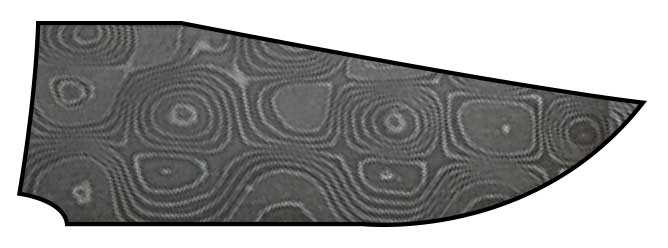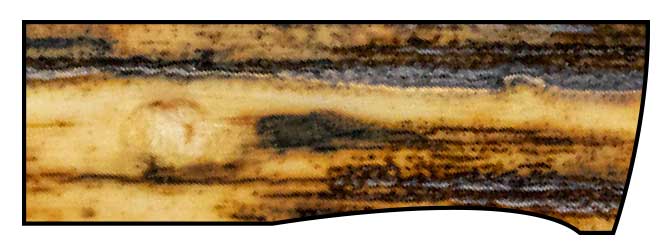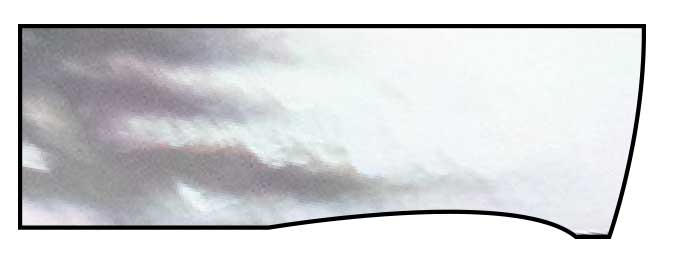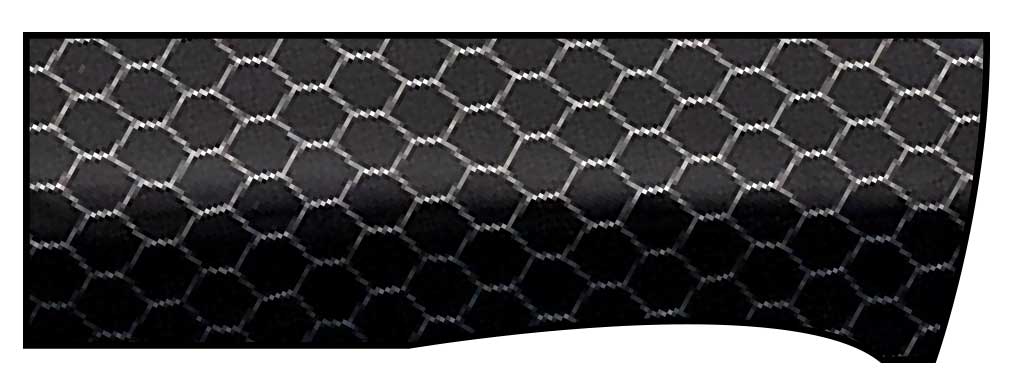Knife Materials
The Steel:
Knife Steel has to meet certain requirements to be a functional knife. It needs to have decent wear resistance, corrosion resistance, flexibility and hardness.
Stainless Steel: This steel has a higher melting point and is much more difficult to work at heat and is very difficult to weld. Stainless Steel has a lower carbon content and higher chromium which makes the steel more resistant to corrosion.
High Carbon Steel: High Carbon Steel is much easier to weld, and hot work based on it’s lower melting point. However, with lower chromium content, High Carbon Steel is more prone to be corroded.

Damascus Steel: Also known as pattern welded steel. This is a method of combining two different steels. Typically, it is 15N20 (nickel steel) and a high carbon steel. These are stacked into layers and forge welded together, cut, shaped and folded to make a pattern. Once this is complete, the knife maker will acid etch the blade to reveal a contrasting pattern of the combined steels. There are numerous patterns, and styles; with each maker bringing their own flare for steel.
San Mai Steel: San Mai is a literal translation to mean “three layers”. Basically, Damascus Steel Lite. Traditionally, there are three layers forming the blade, a hardened steel cutting edge and mild steel or carbon steel forming the sided of the blade.
Guard Materials:
Steel: Most makers that create steel guards use 416 stainless steel or 304 stainless steel. This allows for a good scratch resistance and polish retaining. Stainless steel is easily machined to allow perfect edges and consistency through the manufacturing process.
Carbon Fiber: Carbon fiber is a braided or weaved mesh mixed with a glue or epoxy compound and then vacuum formed followed by a heating process to make forms or sheets. This makes carbon fiber incredibly durable and light weight. This material is easily machined and polished:
Nickel Silver: Nickel Silver is not silver. It is a brass composite of 60% copper, 20% nickel, and 20% zinc. The nickel is what gives it the silver-yellow appearance instead of the yellow appearance of brass. This is a softer metal and is very easy to cold work. Nickel Silver is not scratch resistant however is quickly polished back to high shine.
Brass: A composite of Copper and Zinc. It is very easy to polish and shape, however, corrodes quickly. This material is easy to maintain and quick to shape. This is the easiest of the Copper Composites to mold and cast.
Bronze: A Copper composite that is mixed with tin. The tin is usually 12-12.5% of the total weight. This material produces a very lovely finish and needs little to no maintenance. Bronze machines easily and has a nice wear resistance.
Copper: The bane of knife makers everywhere. Copper is a great base element for composites to make it easier to work. It is very difficult to cold work and requires many rounds of heat treating and quenching to complete a project. Very few knife makers utilize copper due to its difficult nature.
Aluminum: Aluminum is a base metal that has amazing corrosion resistance and is easy to work with. This is one of the lightest metals for its size. It is a simple process to mold and cast with a fairly low melting point.
Mokume: This is layered metals that produce a pattern. Typically, it is copper, brass or zinc, however titanium is very common on todays market. The metals are stacked, heated in a vacuum, cut and restacked to make a particular pattern.
Guard less: That is a common style in modern knives. Many knife makers will create a ergonomically correct handle shape that prevents the end users hand from slipping. However, in a user knife, this can be an issue. If there is nothing preventing the hand from sliding to the blade, the user can be cut.
Natural Handles:

Bone: Most bone handle knives feature cow, camel, giraffe, zebra or fossil bones. They produce different effects during the drying process. Camel produces cracks, while giraffe produces lines. Most fossils produce a spotted appearance. Most fossil bones come from wooly mammoths and mastodons.
Horn: Despite popular belief horn is not bone. Horn is hair of an animal. Hair expands and contracts based on humidity. Lower humidity horn will shrink, and in higher humidity will expand. This can produce issues in the fit and ability to last. It is an amazing handle material when treated properly. Examples are buffalo horn, impala horn, kudu and rams horn.
Antler: This is bone, bone does not expand or contract unless it is shocked into a different humidity. Antler is very durable and easy to maintain.
Tusk: There are numerous forms of tusk available legally in most places. The most common on newer knives is Mammoth Ivory. Not to be confused with the now illegal Elephant Ivory. There are many fossils that are 10’s, 20 thousand 200,000 years old that had tusk. Warthog, and walrus are additional common fossils that used widespread. Most natural ivory has an appearance that is similar to other ivories. However, fossil ivory picks up its coloration from the minerals near it. Blue hues are iron, green is copper and do on. Common fossil finds are in the artic circle.
Stone: Most stone can be suitable for knife handles. It does however take a very special skill set and tools to complete projects that use lapidary techniques for finish work. In this world there are stones of every color imaginable and combinations. Most common stones are hard rock, metamorphic rocks and the like. Soft stone breaks and needs to be replaced often.

Shell: Pearl Shells and Abalone. There are a few types of shells that are commonly used in knife production. Mother of Pearl produces a pearlescent shimmer of whites, greens, pinks and yellows. Black Lip Pearl produces a darker brown, green and pink. Gold Lip Pearl has yellow as the base, and mixes green, red, white and pink. These are coated in a resin to allow the
Specialty:
Man Made Handles:
Micarta: Multi-Layered material soaked and pressed into board or block forms. Comes in paper, linen, canvas, Kevlar and burlap. Insanely durable and takes an amazing polish. Will fade colors in time.

C-Tek: Aluminum or steel matrix filled with resin. Made in a pressure system. Quite durable and fairly easy to work.
Carbon Fiber: Carbon filaments coated in a resin and backed. Very high strength, low weight and strong resistance.
G-10: This material is a basic fiberglass; it shapes well and once supported by glue and steel becomes a durable material. Without the support of steel, this can break very easily.
Resin: Polymerized Plastic. This is a 2 part mix, when molded, that becomes a solid once vacuum/pressure is applied, this hardens into a moderate density shape. People add different materials to alter the pattern and design of the Resin.
Titanium: Ti 22 on the periodic table. This is an incredibly strong material that is insanely light. The most common type in the production process is 6160 and as an alloy the most common is 6AL-4V. This is normally anodized with a chemical solution of electrolytes and electricity. The various voltage gives it the unique colors.
Timascus and Black Ti: An amazing Pattern Welded Titanium Composite. Very light and durable that when heated shows brilliant colors. Timascus can be chemically anodized however, does not have the same brilliance.
Mokume: Another Pattern Welded material that is typically made from copper, brass, zinc, gold, rose gold or platinum. There are numerous combinations, patterns and are formed under moderate heat and made into a billet.
Steel: Handles that are made from steel are very common. Carbon, Stainless, Blued, Damascus are all common types of steel used. Each has different attributes, weights and wear resistance.
